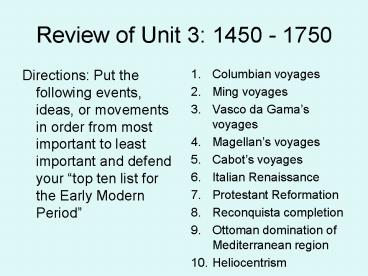Review of Unit 3: 1450 - 1750 - PowerPoint PPT Presentation
1 / 21
Title:
Review of Unit 3: 1450 - 1750
Description:
Review of Unit 3: 1450 - 1750 Directions: Put the following events, ideas, or movements in order from most important to least important and defend your top ten ... – PowerPoint PPT presentation
Number of Views:127
Avg rating:3.0/5.0
Title: Review of Unit 3: 1450 - 1750
1
Review of Unit 3 1450 - 1750
- Directions Put the following events, ideas, or
movements in order from most important to least
important and defend your top ten list for the
Early Modern Period
- Columbian voyages
- Ming voyages
- Vasco da Gamas voyages
- Magellans voyages
- Cabots voyages
- Italian Renaissance
- Protestant Reformation
- Reconquista completion
- Ottoman domination of Mediterranean region
- Heliocentrism
2
Period 5 Industrialization and Global
Integration c. 1750 to c. 1900
- 5.3. Nationalism, Revolution, and Reform
- 5.2. Imperialism and Nation-State Formation
- 5.1 Industrialization and Global Capitalism
- 5.4. Global Migration
3
Unit 5 Outline
- 19th c. Reforms in Social Structures and Gender
Structures - Hyde Park debates
- Chart for comparing 19th century revolutions
- Silent Discussion on Nationalism
- Imperialism images
- Unit Review idea
4
Rank the processes shown on the map from most
important to least important.
5
Unit 4 1750 - 1914
Who are these men?
6
Unit 4 1750 1914, p. 62
- Six Weeks Industrialization, Modernization, and
Reactions - Week One Enlightenment, John Locke, American,
French, Haitian, and Latin American Revolutions,
and Napoleon - Week Two British Industrial Revolution and
De-Industrialization of India and Egypt - Week Three Imperialism and Industrialization
- Timed writing Compare Chinese and Japanese
Reactions to Western Imperialism (2002 exam) - Week Four Nationalism and Modernization
- Week Five Anti-Slavery, Suffrage, Labor, and
Anti-Imperialist movements as Reactions to
Industrialization and Modernization - Timed Writing DBQ on Asian Indentured Labor in
the 19th century (2003 exam) - Week Six Chinese, Mexican, and Russian
Revolutions as Reactions to Industrialization and
Modernization - Map Quiz Imperialism
- Unit Test
7
Comparative and CCOT Chart for 19th Century
Revolutions, p. 85
8
Nineteenth Century Reforms in Social and Gender
Structures, p. 86
9
Hyde Park Project Reform Movements in 19th
Century England, p. 87
10
Silent Discussion on Nationalism, pp. 89-90
11
Pacific Century
- Video critique
12
Skill Focus Historical Causation,Tab 2, p. 11
- Identify, analyze, and evaluate the relationships
between multiple historical causes and effects,
distinguishing between those that are long-term
and proximate, and among coincidence, causation,
and correlation.
13
Sample Multiple-Choice Question,Tab 2, p. 97
- Which of the following factors represents the
most significant cause of the growth of cities in
Afro-Eurasia in the period 1000-1450? - (A) Climate change
- (B) Increased interregional trade
- (C) Decreased agricultural productivity
- (D) Increased invasions
14
Rationale for Correct Answer
- (B) Best answer. The increased volume of
interregional trade had the most significant
effect on the increase in the size and number of
cities in Afro-Eurasia from 1000 to 1450.
15
Rationales for Wrong Answers
- (A) Incorrect. Climate change was not a factor
that consistently favored the growth of cities in
this period in fact, the periods major instance
of climate change the beginning of the Little
Ice Age in the mid-1300s probably discouraged
urban growth, especially in Europe. - (C) Incorrect. Agricultural productivity actually
increased in many parts of Afro-Eurasia in this
period as a result of the spread of unique crops
from South and Southeast Asia, and more efficient
agricultural techniques to East Asia, Southwest
Asia and the Mediterranean regions. - (D) Incorrect. Increased invasions due to nomadic
incursions or imperial wars of expansions likely
would have decreased the number and size of
cities at least during the times of conflict.
16
Focus Causation Skills Activity, Tab 1, p. 16
Directions In pairs or small groups, discuss the
difference between long term and short term
causes and effects. Then examine the items listed
and sort them into the appropriate columns for
causes and effects of the Meiji Restoration.
Hint use highlighters.
17
Focus Causation Skills Activity,Tab 1, p. 16
- Directions
- In pairs or small groups, discuss the difference
between long term and short term causes and
effects. Then examine the items listed and sort
them into the appropriate columns for causes and
effects of the Meiji Restoration. Hint use
highlighters.
18
Strategies for Historical Thinking Skills
- Reflect on Activity
- Discuss use of activity with your students
- Share more best practices for teaching causation
skill
19
Resistance to Imperialism
- POV of images, p. 93
- DBQ 2009, CB Handbook, pp.
- DBQ 2010, Exam Materials packet
20
Migrations Special Focus Book
- Read either the Marcus Garvey or the Patrice
Lumumba/Salvador Allende lesson and decide how
you might use it in your class.
21
Review for Unit 4, p. 94































